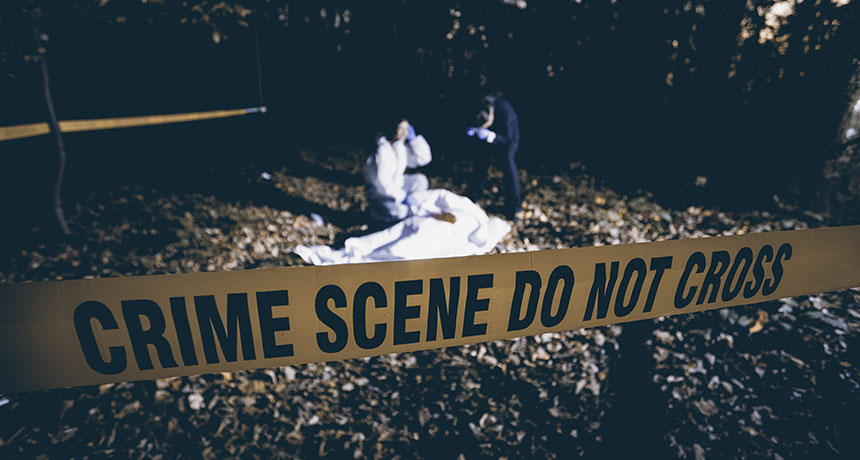Microbes may be a forensic tool for time of death

By using an ecological lens to examine dead bodies, scientists are bridging the gap between forensic science and the ecological concept of succession.
mangostock/Shutterstock
- More than 2 years ago
There is life after death. And it’s kind of gross.
For most of us, death means life (as we know it) is over, kaput, finis. Whatever we believe about a continued existence metaphysically, when we die, our body’s time on Earth comes to an end. But for the microbes living within us, time marches on. And if you are a microbial ecologist, that’s when things get interesting.
“Once your heart stops beating, your cells stop getting oxygen and start bursting open,” says Jennifer DeBruyn of the University of Tennessee in Knoxville. “This releases all kinds of great stuff — think a dessert buffet-type situation — and the microbes start feasting.” DeBruyn, who typically studies the communities of microbes in soils, is one of a handful of researchers probing such communities in and on cadavers.
The structured process of change in a community over time (for example, after a forest fire), called succession, has long interested ecologists. And the predictable series of insects that colonize a decaying body has long interested forensic scientists. But for nearly a century, these parallel fields of research haven’t had much to do with each other. By using an ecological lens to examine dead bodies, DeBruyn and her colleagues are starting to bridge that gap.
One avenue of research is the changing microbial community in the soil beneath decomposing bodies. While most of the ecological research on decomposition looks at plant litter, DeBruyn and her colleagues argue that the decomposition of carcasses — say, of a dead antelope on the African plain — may also have important implications for nutrient cycling in the larger landscape. They started pursuing that idea a little closer to home, collecting soil from beneath four human cadavers at the University of Tennessee’s outdoor human decomposition laboratory (technically the Anthropology Research Facility, aka the Body Farm).
“Stuff mostly turns to liquid,” DeBruyn told me. “You get these gooey soil decomposition islands.”
But these puddles of decay aren’t static; the researchers documented two distinct shifts in the soil microbial community within them. One occurs when the body’s integrity is compromised (technically, during the bloat and bloat-active stages), and decomposition fluids gush into the soil. Chemical analyses reveal that during this window, there’s an uptick in extractable carbon and nitrogen (particularly ammonia), and the production of biomass goes up. Then, when most tissue has decomposed (the active to advanced decay stages), biomass production slows, the team reported June 12 in PLOS ONE.
The researchers also found that human-associated Bacteroides species, which thrive in the guts of mammals, persisted in some of the soil samples a whopping 198 days after the cadavers were placed. This suggests that soil microbes beneath a body could help forensic estimates of the “postmortem interval,” or time since death.
Related work by DeBruyn, Kathleen Hauther, a doctoral student in DeBruyn’s lab, and others suggests that microbial sampling of the human gut itself might also serve as a time-since-death stamp. Hauther speculated that changes in the community of gut microbes might offer an internal signal that would remain consistent regardless of where and when death strikes.
So the team regularly swabbed the gut of six bodies donated to the Body Farm over nine to 20 days, duct-taping the incisions to prevent insects from moving in. It was messy work. “We sampled until things turned to mush and we couldn’t find the intestines anymore,” DeBruyn says.
While the research is preliminary, the results suggest that there’s a discernible shift in the community when gut microbes go from digesting our food to digesting our bodies. Quantifying the relative abundances of three ubiquitous genera of gut microbes — Bacteroides, Lactobacillus and Bifidobacterium — revealed that populations of Bacteroides andLactobacillus peter out in a predictable manner, the team reported in June in the Journal of Forensic Sciences. This finding suggests that if at least two samples are taken, allowing calculation of a rate of change, these bacterial genera might be a good way to backtrack to time of death. (The relative abundance of the Bifidobacterium populations didn’t prove useful.)
When the team look at the entire species composition of the decomposing intestines, they found that the kinds of bacteria present shift about halfway through the bloat stage. A few days into bloat, when the body swells with gases, a “decay community” begins to dominate, and bacterial taxa associated with flies, such as Ignatzschineria species, start appearing, the researchers reported in June at the American Society for Microbiology meeting in New Orleans. Previous work focusing on bloat bacteria couldn’t find a consistent signal; the new work offers hope that telltale microbes are out there, DeBruyn says.
The research also suggests that the microbial succession on a cadaver operates similarly to the colonization that occurs in plant communities, where “at first, weedy species thrive — they scoop up the easy-to-eat stuff,” says DeBruyn. In the decomposing gut, it appears that fast-growing microbes initially dominate, chowing down on the suddenly available smorgasbord of glucose, small carbohydrates and proteins. Then slower-growing critters that invest time digesting complex molecules that are energetically expensive to consume move in, akin to the colonization of a field by shrubs and then long-lived trees.
It’s fitting that the microbial succession of a dead body echoes the ecological succession of Earth’s larger biomes. And in a recent review article documenting the history of the notion of succession, scholars argue that the forensic science community and ecology research community could benefit greatly from cross-pollination efforts, like DeBruyn’s. One noted stumbling block: ecologists are typically looking forward in time, trying to predict future change, while forensic scientists are looking back in time, trying to predict time of death. Perhaps it’s time they start working together.







